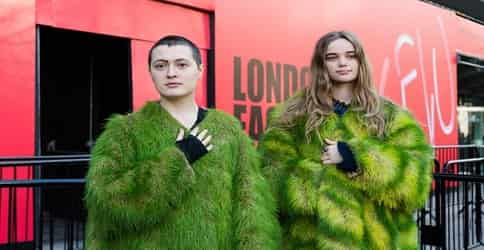
Putting real fur down a runway in 2019 is almost guaranteed to cause some backlash. After the ’90s saw a wave of animal activists calling real fur immoral, with Naomi C. and Cindy Craw. posing nude for PETA for its “I’d rather go naked than wear fur” campaign in 1994, we are well into the faux-fur era. But now there’s another pressing debate: Is faux fur worse for the environment?
For the purpose of the law, fur is defined as “animal skin or part thereof with hair, fleece or fur fibers attached thereto.” For the purposes of shoppers, that means mink, sable, chinchilla, lynx, fox, rabbit, beaver, coyote and other luxury furs.
Exceptions have been made for cowhide, deerskin, sheepskin and goatskin. Which means that shearling is totally fine.
Brands such as Prada, Burberry, Versace, Michael Kors, Armani, and McCartney have all taken a stand against using real fur. We haven’t stopped wearing fur look-alikes. As people turn to faux fur, the market is producing realistic-looking alternatives. The issue then becomes that most are made from synthetic materials.

So, Fur kills animals, faux fur kills the environment. What is better?
Those are the two sides of the long-running real fur versus faux fur debate. Both sides trying to convince the public of the sustainability and relative merits of their products. The fur industry, however, is at a current low. Search high and low, you will struggle to find any real fur on the high street.
Faux fur has long been thought of as an ethical alternative to the real thing. And, for the most part, it is. When you buy faux, for the most part you know no animal has been harmed, although there have been some notable cases where fur that was sold as fake turned out to be real. Animals living on fur farms spend their time locked up in small cages and can be tortured or cruelly killed, states PETA. (Some farms are regulated by welfare programmes such as Welfur, but several countries have banned them.)
Opting for faux fur should eliminate the animal welfare issue. But it doesn’t remove the planetary impact, especially when bought for a low cost. Popularised in the 1950s, per Fashionista, fake fur tended to be created by chemical companies. And there lies the still-existent problem.
Today’s faux fabric is made up of synthetic fibres; many, including acrylic and polyester, are forms of plastic. Acrylic had the worst environmental impact of nine fibres studied in a 2014 report by the European Commission.
Instead of comparing fur to non-fur textiles, the pro-fur study compared a real mink fur coat to a faux fur one, assuming a real fur coat is typically kept for 30 years compared to a faux fur coat that’s kept for six. With that assumption, it showed that a faux fur coat poses four times more risk of damage to the ecosystem, 2.3 times more risk of adding to climate change, and 2.7 times more risk of impacting resource consumption. (Risk to human health was about the same, though that switched in favor of faux fur if you decide that people usually keep a faux fur coat for eight years or more.)
- Magnetic storms: the sun is testing the planet🌪️ - 13.06.2024
- Why You Should Drink Chicory: Benefits and Harms 🌿 - 09.06.2024
- Innovative Choice: Sproud Milk – Your Ideal Plant-Based Drink 🌱 - 03.06.2024


